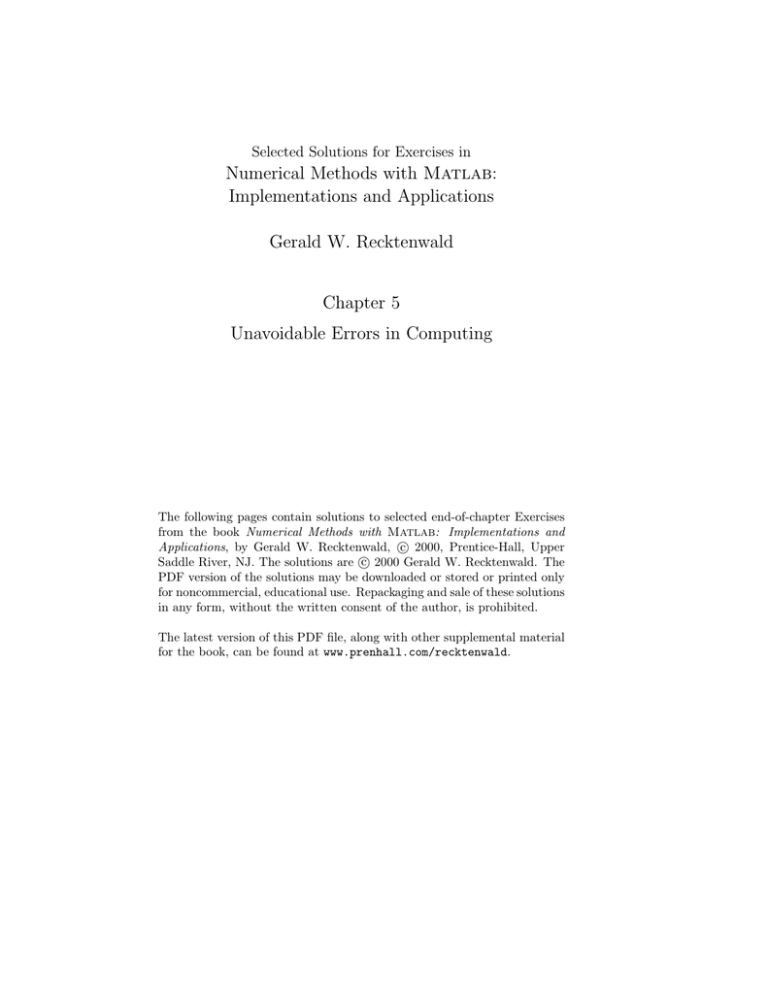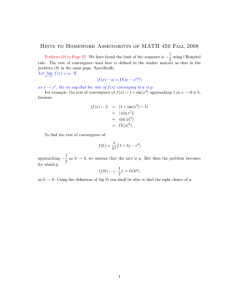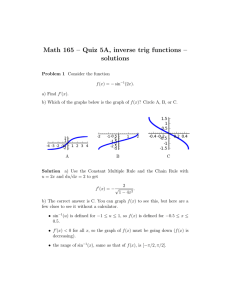Numerical Methods with Matlab: Implementations and Applications
advertisement

Selected Solutions for Exercises in
Numerical Methods with Matlab:
Implementations and Applications
Gerald W. Recktenwald
Chapter 5
Unavoidable Errors in Computing
The following pages contain solutions to selected end-of-chapter Exercises
from the book Numerical Methods with Matlab: Implementations and
c 2000, Prentice-Hall, Upper
Applications, by Gerald W. Recktenwald, c 2000 Gerald W. Recktenwald. The
Saddle River, NJ. The solutions are PDF version of the solutions may be downloaded or stored or printed only
for noncommercial, educational use. Repackaging and sale of these solutions
in any form, without the written consent of the author, is prohibited.
The latest version of this PDF file, along with other supplemental material
for the book, can be found at www.prenhall.com/recktenwald.
2
Unavoidable Errors in Computing
5–3 Convert the following numbers to normalized floating-point values with eight-bit mantissas:
0.4, 0.5, 1.5.
Partial Solution: 0.4 = 0.4 × 100 is already is already in normalized format. Converting
0.4 to a binary number using Algorithm 5.1 gives (0 1100 1100 1100 . . .)2 . To eight bits we get
0.4 = (01100110)2 . Converting (01100110)2 back to base 10 with Equation (5.2) gives
0 × 2−1 + 1 × 2−2 + 1 × 2−3 + 0 × 2−4 + 0 × 2−5 + 1 × 2−6 + 1 × 2−7 + 0 × 2−8
1
1
1 1
+
= 0.398437500
= + +
4 8 64 128
5–9 Modify the epprox function in Listing 5.2 on page 207 so that vectors of n and abs(f-e) are
saved inside the loop. (Hint: Create the nn and err vectors, but do not modify the loop index
n.) Remove (i.e., comment out) the fprintf statements, and increase the resolution of the
loop by changing the for statement to for n=logspace(1,16,400). Plot the variation of the
absolute error with n. Do not connect the points with line segments. Rather, use a symbol,
such as ’+’ for each point. Explain the behavior of the error for n > 107 .
Partial Solution: The epproxPlot function, listed below, contains the necessary modifications. Running epproxPlot produces the plot on the following page. Explanation of the plot
is left as an exercise to the reader.
function epproxPlot
% epproxPlot Plot error in approximating e = exp(1) with the f(n)
%
f(n) = lim_{n->infinity} (1 + 1/n)^n
%
% Synopsis: y = epproxPlot
%
% Input:
none
%
% Output:
Plot comparing exp(1) and f(n) = (1 + 1/n)^n as n -> infinity
%
%
Ref:
N.J. Higham, Accuracy and Stability of Numerical Algorithms,
1996, SIAM, section 1.11
e = exp(1);
% fprintf(’\n
n
f(n)
error\n’);
k=0;
for n=logspace(1,16,400)
f = (1+1/n)^n;
% fprintf(’%9.1e %14.10f %14.10f\n’,n,f,abs(f-e));
k = k + 1;
nn(k) = n;
err(k) = abs(f-e);
end
loglog(nn,err,’+’);
xlabel(’n’);
ylabel(’Absolute error in f(n)’);
[minerr,imin] = min(err);
fprintf(’\nMinimum error = %11.3e occurs for n = %24.16e in this sample\n’,...
minerr,nn(imin));
c 2000, Gerald W. Recktenwald. Photocopying is permitted only for non-commercial educational purposes.
Copyright Chapter 5: Unavoidable Errors in Computing
3
2
10
0
10
-2
Absolute error in f(n)
10
-4
10
-6
10
Plot of solution to
Exercise 5–9.
-8
10
-10
10
0
10
2
10
4
10
6
10
8
10
n
10
10
12
10
14
10
16
10
5–19 Implement the combined tolerance |xk − xk−1 | < max [∆a , δr |xk−1 |] in the newtsqrt function
in Listing 5.3. Note that ∆a and δr should be separate inputs to your newtsqrt function. As a
diagnostic, print the number of iterations necessary to achieve convergence for each argument
of newtsqrt. Based on the results of Example 5.6, what are good default values for ∆a and δr ?
If ∆a = δr , is the convergence behavior significantly different than the results of Example 5.6?
Is the use of an absolute tolerance helpful for this algorithm?
Partial Solution: The Matlab part of the solution is implemented in the newtsqrt and
testConvSqrt functions listed below. The newtsqrt function is a modified version of the
newtsqrtBlank.m file in the errors directory of the NMM Toolbox. The modified file is saved
as newtsqrt.m. The testConvSqrt function is a modified version of testsqrt function in
Listing 5.4.
The inputs to newtsqrt
√ are x, the argument of the square root function (newtsqrt returns
an approximation to x), deltaA, the absolute tolerance, deltaR, the relative tolerance, and
maxit, the maximum number of iterations. Note that the newtsqrt function has two input
tolerances, whereas the newtsqrt function in Listing 5.3 has only one tolerance (delta). The
default tolerances in testConvSqrt are
deltaA = 5εm = 1.11 × 10−15
deltaR = 5 × 10−6
The absolute tolerance is designed prevent unnecessary iterations: values of r − rold less than
εm are meaningless due to roundoff. The relative tolerance corresponds to a change in the
estimate of the root of less than 0.05 percent (0.0005) on subsequent iterations.
c 2000, Gerald W. Recktenwald. Photocopying is permitted only for non-commercial educational purposes.
Copyright 4
Unavoidable Errors in Computing
function testConvSqrt(deltaA,deltaR)
% testConvSqrt Test alternative convergence criteria for the newtsqrt function
%
% Synopsis: testConvSqrt
%
testConvSqrt(deltaA)
%
testConvSqrt(deltaA,deltaR)
%
% input: deltaA = (optional) absolute convergence criterion
%
Default: deltaA = 5e-9
%
deltaR = (optional) relative convergence criterion
%
Default: deltaR = 5e-6
if nargin<1,
if nargin<2,
xtest = [4
deltaA = 5*eps; end
deltaR = 5e-6; end
0.04
4e-4
4e-6
4e-8
4e-10
4e-12];
% arguments to test
fprintf(’\n Combined Convergence Criterion\n’);
fprintf(’\t\t deltaA = %12.4e\t\t deltaR = %12.4e\n\n’,deltaA,deltaR)
fprintf(’
x
sqrt(x)
newtsqrt(x)
error
relerr
it\n’);
for x=xtest
% repeat for each column in xtest
r = sqrt(x);
[rn,it] = newtsqrt(x,deltaA,deltaR);
err = abs(rn - r);
relerr = err/r;
fprintf(’%10.3e %10.3e %10.3e %10.3e %10.3e %4d\n’,x,r,rn,err,relerr,it)
end
function [r,iter] = newtsqrt(x,deltaA,deltaR,maxit)
% newtsqrt
Use Newton’s method to compute the square root of a number
%
% Synopsis: r = newtsqrt(x,delta,maxit)
%
[r,it] = newtsqrt(x,delta,maxit)
%
% Input: x
= number for which the square root is desired
%
delta = (optional) convergence tolerance. Default: delta = 5e-9
%
maxit = (optional) maximum number of iterations. Default: maxit = 25
%
% Output:
r = square root of x to within combined tolerance
%
abs(r-rold) < max( deltaA, deltaR*abs(rold) )
%
where r is the current guess at the root and rold
%
is the guess from the previous iteration
%
it = (optional) number of iterations to reach convergence
if
if
if
if
if
x<0, error(’Negative input to newtsqrt not allowed’);
x==0,
r=x; return;
end
nargin<2, deltaA = 5*eps; end
nargin<3, deltaR = 5e-6; end
nargin<4, maxit=25;
end
end
r = x/2; rold = x;
% Initialize, make sure convergence test fails on first try
it = 0;
while abs(r-rold) > max( [deltaA, deltaR*abs(rold)] ) & it<maxit % Convergence test
rold = r;
% Save old value for next convergence test
r = 0.5*(rold + x/rold);
% Update the guess
it = it + 1;
end
if nargout>1, iter=it; end
The reader is left with the task of running testConvSqrt and discussing the results. What
happens if the call to testConvSqrt is testConvSqrt(5e-9)? Which tolerance, the absolute
or the relative (or both, or neither) is more effective at detecting convergence?
c 2000, Gerald W. Recktenwald. Photocopying is permitted only for non-commercial educational purposes.
Copyright Chapter 5: Unavoidable Errors in Computing
5
5–23 Use the sinser function in Listing 5.5 to evaluate sin(x), for x = π/6, 5π/6, 11π/6, and
17π/6. Use the periodicity of the sine function to modify the sinser function to avoid the
undesirable behavior demonstrated by this sequence of arguments. (Hint: The modification
does not involve any change in the statements inside the for...end loop.)
Partial Solution: The output of running sinser for x = 17π/16 is
>> sinser(17*pi/6)
Series approximation to sin(8.901179)
k
1
3
5
7
9
11
13
15
17
19
21
23
25
27
29
term
8.901e+00
-1.175e+02
4.656e+02
-8.784e+02
9.666e+02
-6.963e+02
3.536e+02
-1.334e+02
3.886e+01
-9.003e+00
1.698e+00
-2.659e-01
3.512e-02
-3.964e-03
3.868e-04
ssum
8.90117919
-108.64036196
357.00627682
-521.41383256
445.22638523
-251.02690828
102.59385039
-30.82387869
8.03942600
-0.96401885
0.73443795
0.46848851
0.50360758
0.49964387
0.50003063
Truncation error after 15 terms is 3.06329e-05
ans =
0.5000
Due to the large terms in the numerator, the value of the series first grows before converging
toward the exact value of 0.5. Since the large terms alternate in sign, there is a loss of precision
in the least significant digits when the large terms with opposite sign are added together to
produce a small result. Thus, even if more terms are included in the series, it is not possible to
obtain arbitrarily small errors. Evaluating the series for the sequence x = π/6, 5π/6, 11π/6,
17π/6,. . . requires an increasing number of terms, even though | sin(x)| = 1/2 for each x in the
sequence.
The results of running sinser for x = π/6, 5π/6, 11π/6, and 17π/6 are summarized in the
table below.
x
Terms
Absolute Error
π/6
6
3.56 × 10−14
5π/6
10
1.16 × 10−11
11π/6
15
4.40 × 10−11
17π/6
15
3.06 × 10−05
For smaller values of x, the series converges with fewer terms. The error in the approximation
to sin(x) grows as |x| increases.
c 2000, Gerald W. Recktenwald. Photocopying is permitted only for non-commercial educational purposes.
Copyright 6
Unavoidable Errors in Computing
To reduce the effect of roundoff for large x we exploit the periodicity of sin(x): the value of
sin(x) is the same for x ± 2nπ for n = 1, 2, . . .. Thus, whenever |x| > 2π we can remove an
integer factor of 2π before evaluating the series. Removing an integer factor of 2π is easily
achieved with the built-in rem function. rem(a,b) returns the remainder (fractional part) of
a/b. To apply this to the sinser code, insert
x = rem(x,2*pi);
before the evaluation of the series. This fix is implemented in sinserMod (not listed here).
Running sinserMod for x = 11π/6 gives
>> s = sinserMod(17*pi/6)
Series approximation to sin(2.617994)
k
1
3
5
7
9
11
13
15
17
19
term
2.618e+00
-2.991e+00
1.025e+00
-1.672e-01
1.592e-02
-9.920e-04
4.358e-05
-1.422e-06
3.584e-08
-7.183e-10
ssum
2.61799388
-0.37258065
0.65227309
0.48502935
0.50094978
0.49995780
0.50000139
0.49999996
0.50000000
0.50000000
Truncation error after 10 terms is 1.15644e-11
s =
0.5000
The sinserMod function obtains a more accurate result than sinser, and it does so by evaluating fewer terms.
A even better solution involves recognizing that sin(x) for all x can be constructed from a table
of sin(x) values for 0 < x < π/2. The diagram below indicates how values of sin(x) versus x
can be used to generate sin(x) values for any x.
1.5
1
0.5
0
Exercise 5–23. All values of
sin(x) can be generated from
sin(x) versus x in 0 ≤ x ≤ π/2.
-0.5
-1
-1.5
-8
-6
-4
-2
0
2
4
6
8
c 2000, Gerald W. Recktenwald. Photocopying is permitted only for non-commercial educational purposes.
Copyright Chapter 5: Unavoidable Errors in Computing
7
The following table gives additional clues on how to implement a more efficient and more
accurate sinser
Range of x
π
<x<π
2
3π
π<x<
2
3π
< x < 2π
2
Simplification
sin(x) = sin(π − x)
sin(x) = − sin(x − π) = sin(x − π)
sin(x) = − sin(2π − x) = sin(x − 2π)
The range of x < 0 is handled with the identity sin(x) = − sin(x).
The following Matlab code provides additional hints on the implementation.
x = rem(x,2*pi);
if x==0
ssum = 0;
return;
elseif x==pi/2
ssum = sign(xin);
return;
elseif x>pi/2 & x<pi
x = pi - x;
...
The goal of the more sophisticated code is to use the absolute minimum number of terms in the
series approximation. Reducing the number of terms makes the computation more efficient,
but more importantly, it reduces the roundoff.
The improved code is contained in the sinserMod2 function, which is not listed here. The
demoSinserMod2 function compares the results of sinserMod and sinserMod2 for x = π/6,
5π/6, 11π/6, and 17π/6. Running demoSinserMod2 gives
>> demoSinserMod2
x*6/pi
-17.00
-11.00
-5.00
-1.00
1.00
5.00
11.00
17.00
-- sinserMod -n
err
10
1.156e-11
15
-4.402e-11
10
1.156e-11
6
3.564e-14
6
-3.564e-14
10
-1.156e-11
15
4.402e-11
10
-1.156e-11
-- sinserMod2 -n2
err2
6
3.558e-14
6
-3.558e-14
6
3.564e-14
6
3.564e-14
6
-3.564e-14
6
-3.564e-14
6
3.558e-14
6
-3.558e-14
For the same tolerance (5 × 10−9 ) sinserMod2 obtains a solution that is as or more accurate
than sinserMod, and it does so in fewer iterations. For x = ±5π/6 the two functions are
identical. Complete implementation and testing of sinserMod and sinserMod2 is left to the
reader.
c 2000, Gerald W. Recktenwald. Photocopying is permitted only for non-commercial educational purposes.
Copyright 8
Unavoidable Errors in Computing
5–27 Derive the Taylor series expansions P1 (x), P2 (x), and P3 (x) in Example 5.9 on page 222.
Partial Solution: The Taylor polynomial is given by Equation (5.15)
df (x − x0 )2 d2 f (x − x0 )n dn f Pn (x) = f (x0 ) + (x − x0 )
+
+ ··· +
dx x=x0
2
dx2 x=x0
n!
dxn x=x0
Given f (x) = 1/(1 − x) we compute
+1
df
=
dx
(1 − x)2
d2
+2
=
2
dx
(1 − x)3
d3
+6
=
3
dx
(1 − x)4
Thus
P1 (x) = f (x0 ) + (x − x0 )
dn
n!
=
n
dx
(1 − x)n+1
1
(1 − x0 )2
c 2000, Gerald W. Recktenwald. Photocopying is permitted only for non-commercial educational purposes.
Copyright



